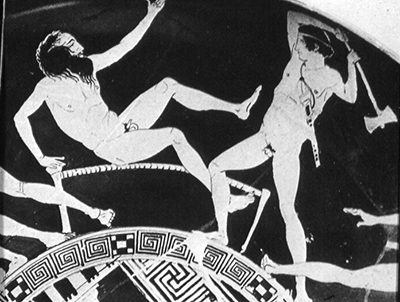Procrustes
In his introduction to 'Pataphysics: The Poetics of an Imaginary Science, Christian Bök describes science as having "procrustean constraints” (1998, p. X). Procrustes, in Greek mythology, was a blacksmith-turned-robber who lived on a well-traveled route. He would offer passersby a place to rest, and when they went to sleep he would physically mutilate them by stretching or cutting off their limbs, to make them conform to the size of his iron bed. The word quantum comes from quantity, and until the early 20th century it was defined as: a particular amount. To quantize is “to restrict (a variable quantity) to discrete values rather than to a continuous set of values” (Dictionary.com, 2015). Therefore, in physics, a quantum (plural: quanta) is not simply a particular amount, but the smallest amount: "the smallest quantity of radiant energy, equal to Planck's constant times the frequency of the associated radiation" (Dictionary.com, 2015).

Procrustes, source: the Internet.
Quantum theory is considered the basis of modern physics and began in 1900 when Max Planck suggested that light was delivered in quantized units. A beam of light is not continuous, but rather, it is made up of billions of quanta of light, now called photons. What proceeded from this notion became known as quantum mechanics, the branch of physics dedicated to the study of physical phenomena at nanoscopic scales.
Physics, then, not only operates under procrustean constraint but also applies procrustean constraint. By now, all known matter has been chopped, dismembered and stretched to fit into the iron bed of physics. In 1997 physicist David Deutsch wrote, “Even for quantities like distance (between two atoms, say) the notion of a continuous range of possible values turns out to be an idealization. There are no measurable continuous quantities in physics” (1997, NP). In other words, everything is quantized: any amount of light, energy or momentum can only be a multiple of the fundamental unit of light, energy or momentum.
Before describing one of the more striking quantum phenomena that lays in the trough of imagination’s wave, I must first elaborate on the philosophical epiphenomenon that occurs at this scale: that of the “factish.” Factish is a neologism combining fact and fetish coined by philosopher Bruno Latour. Factishes are defined by Latour and Isabelle Stengers as “those beings we fabricate and that fabricate us, from which the scientist (or the technician, via different modes) receives autonomy by giving [them] an autonomy he does not have” (2010, p.23). For Stengers, physicists have not merely chopped light into photons but have whittled them into existence. In this view, the procrustean act of quantization becomes a method of creation—a scientist is a maker. And the paradox is “that the beings fabricated by physicists may nonetheless be referred to as ‘real,’ endowed, no matter that they are ‘fabricated,’ with an autonomous existence” (Stengers, 2010, p.19). Therefore, photons are "factishes." Planck postulated them several years before Einstein formulated their existence, twenty years before they were named and even longer before any devices such as the photomultiplier were invented to "detect" them. Yet they were and are considered elementary particles of the universe.
In Cosmopolitics I, Stengers' argues for a socio-scientific worldview in which two positions could exist together, i.e. that the photon, or any being brought into existence by science, could "be as old as the period in which its existence was first demonstrated, that is produced, in our laboratories, and that it dates back to the origins of the universe" (2010, p.20). This represents an outlook shift in which scientists would consider a photon to be both a construction and a “fundamental cosmological actor” that allows humans to construct it.
Table of Contents
Scale
Vanishing Exercise
Imagination
Procrustes
Through a Double Slit
No Dreams, No Logic
Erotics of Art and Science
Bibliography
Extra